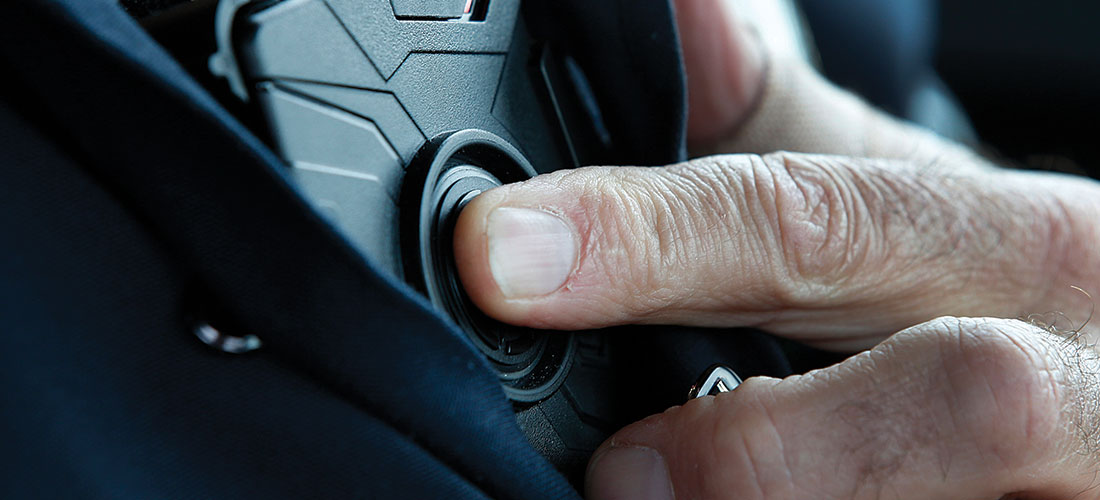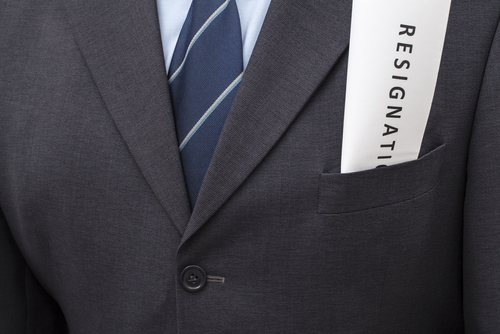For some civil rights lawyers, police body camera video can be hard to come by

Police body cameras can support or contradict accounts of misconduct. (Photo by George Frey/Getty Images)
On an early morning in April, deputies jumped off a Pasquotank County Sheriff’s Office pickup truck, weapons at the ready. They surrounded Andrew Brown Jr.’s blue BMW on the driveway outside his home in Elizabeth City, North Carolina.
“Let me see your hands!” the officers commanded.
Brown, a 42-year-old Black man, reversed, brushing an officer with the side of his car. Police body camera footage showed the car narrowly missing him again as the car skidded forward. A shot cracked in the morning air. As the car retreated across the lawn, the officers fired a volley of rounds.
One of the bullets pierced the back of Brown’s head. He was dead by 8:33 a.m., 10 minutes after the officers arrived.
No deputies were charged. Pasquo-tank County District Attorney Andrew Womble said the deputies’ actions were justified because Brown used the car as a “deadly weapon” as they tried to serve drug-related search and arrest warrants.
But Brown’s family members and their attorney Bakari Sellers say an edited 18-minute version of the video (compiled from multiple cameras and angles), seen only after obtaining a court order, shows the unarmed Brown did not pose a threat as he drove away.
The Brown case is one of many examples in which civil rights attorneys seeking body camera video find police departments, officials and judges can stand in their way. Sometimes, according to lawyers and legal experts, the video is selectively released or edited.
That can leave lawyers with little choice but to file a lawsuit and use discovery and subpoena power to obtain recordings, delaying justice for families wanting a more complete picture of what happened to their loved ones.
Even so, police say there are good reasons to withhold, edit or redact footage to protect the privacy rights of people who appear on camera and prevent interference in ongoing investigations. Officers have also warmed to a technology that can vindicate them and dispel baseless claims of police misconduct.
“I’ve ridden along with officers who have told me point-blank, ‘If this camera was not working properly, I would take a sick day,’” says Sean Smoot, deputy counsel for the Illinois Police Benevolent and Protective Association, a policeunion.
In 2014, calls for body cameras grew louder after a white police officer shot and killed Michael Brown Jr., an 18-year-old Black man, in Ferguson, Missouri. By 2016, almost half of the nation’s 15,300 law enforcement agencies were using them, according to the Bureau of Justice Statistics.
Chad A. Marlow, senior policy counsel for the American Civil Liberties Union, says the period after Ferguson was critical. When it became clear the technology was not going away, police carved out exemptions and exceptions to prevent release. “That is where this strategy developed of taking a device that was rolled out to increase police transparency and accountability and essentially lock it down,” Marlow says.
Disparate laws
Sellers, a CNN pundit who was once a Democratic member of the South Carolina House of Representatives, is part of a legal team behind a $31 million wrongful death and excessive force federal lawsuit on behalf of the administrator of Andrew Brown’s estate. He says the family’s attorneys, which include civil rights lawyer Ben Crump, will use discovery and subpoena power to get officials to hand over all two hours of video of the encounter that led to his death.
Officials showed the family a 20-second clip in private, and Pasquotank County Sheriff Tommy Wooten II said he wanted to release it. In North Carolina, however, officials have some discretion to disclose relevant portions of police body camera video to family members. But the law prevented officials from releasing the video into Andrew Brown family’s possession. State court judges make final decisions on full disclosure and release. In April, Judge Jeffery B. Foster refused to release the full video to the public because he said it was part of an ongoing investigation. But he did allow the family to watch the 18-minute portion behind closed doors.
“By putting that onus on the family, it proved to be an extremely difficult process, one that [the county officials] were not cooperative with because they knew what was on those videos, and those videos would show that Andrew was shot from behind,” Sellers says.
Christopher Geis represents three of the deputies who fired their weapons: Aaron Lewellyn, Daniel Meads and Robert Morgan. He declined to comment on the lawsuit, and a motion to dismiss the case was filed in October.
Typically, a state’s open records laws address police recordings. But police departments may have their own policies and procedures, according to the Brennan Center for Justice. By 2018, the National Conference of State Legislatures reports, 23 states and the District of Columbia had open records laws outlining policies on body camera footage.
Mary D. Fan, a professor at the University of Washington School of Law, says the police may withhold video to protect victims, vulnerable witnesses or people with mental illnesses. But states also have tailored their laws to address requests to see recordings.
In 2021, Colorado made changes to its law and now requires police departments to release recordings within 21 days of a request. Previously, video was released within 21 days of a complaint of misconduct.
In August, the ABA House of Delegates passed a resolution adopting the Principles on Law Enforcement Body-Worn Camera Policies, and it urged governments to adopt standards in accord with those principles.
The principles include a provision ensuring “timely and appropriate access” to footage in line with public records laws. But nationwide, there is a patchwork of policies and laws. States such as Ohio and New Hampshire have laws making it easier to access footage. But Marlow says South Carolina and North Carolina’s laws are two of the most restrictive in the country.
Fan agrees that the bar is high in both of those states, where footage is not part of the public record and the final word is left to state officials. “Police leaders in these restrictive jurisdictions may want to release the footage because they believe it might exonerate them. And yet, they can’t because these laws are so restrictive,” she says.
‘No slam dunk’
Civil rights attorney Sam Aguiar represents Tamika Palmer, the mother of Breonna Taylor, who was shot and killed in March 2020 during a botched police raid when officers fired 32 shots into her apartment.
In July, Aguiar sued the Louisville Metro Police Department in Kentucky for audit trail logs of body cameras to see if the police had more footage. According to the complaint, the police upload their video to a platform called Evidence.com, which keeps logs showing whether cameras were turned on and recording.
Before the widespread use of body cameras, attorneys relied on officers’ sworn statements, which Aguiar says can be self-serving. He suggests attorneys in police misconduct cases file civil lawsuits early to get subpoena power.
Sellers also suggests that lawyers stay calm as they negotiate with officials. “I always try to have a good relationship with county officials or city officials and say, ‘We want to see this video. The family deserves to see this video,’” Sellers says.
Still, some experts were always skeptical that body cameras would bring the change that reform-minded advocates wanted.
“A lot of scholars have been saying visual evidence is no slam dunk. It’s not a transparent window into the truth of what happened,” Fan notes.
A 2014 study in the Journal of Quantitative Criminology suggests the cameras do reduce citizen complaints and use of force; however, a 2017 paper, Evaluating the Effects of Police Body-Worn Cameras, did not “detect any statistically significant” impact on use of force or citizen complaints in Washington, D.C. The study compared officers who wore body cameras with those who did not.
A 2020 paper for Campbell Systematic Reviews covered 30 studies, finding that body cameras “may not substantially affect most officer or citizen behaviors.” But the study did find the technology may reduce the number of citizen complaints.
And Marlow argues Americans are primed not to expect justice when police misconduct is caught on video. “We’re conditioned to see the video of George Floyd and say, ‘That’s not going to be enough.’ When it was enough, it was actually shocking,” says Marlow, referring to former police officer Derek Chauvin’s conviction for Floyd’s murder in April.
Sellers says it’s important that the family and their legal team get a complete picture of what happened to Andrew Brown. The state offered the full video to the family but with a gag order that would have prevented them from making it public. “Why would we agree to that?” Sellers asks. “When people talk about pursuing justice in cases like this, it’s truly a pursuit because the impediments are just high as hell.”
Smoot says when the police decline to release controversial video, they risk eroding trust within the community. He says he usually tells officials to release it early because “bad news does not improve with age.”
This story was originally published in the December 2021/January 2022 issue of the ABA Journal under the headline: “Shot by Shot: For some civil rights lawyers, police body camera video can be hard to come by.”
Write a letter to the editor, share a story tip or update, or report an error.


